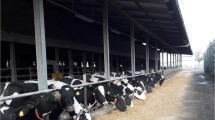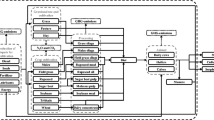Abstract
Background, aim and scope
Studies on the contribution of milk production to global greenhouse gas (GHG) emissions are rare (FAO 2010) and often based on crude data which do not appropriately reflect the heterogeneity of farming systems. This article estimates GHG emissions from milk production in different dairy regions of the world based on a harmonised farm data and assesses the contribution of milk production to global GHG emissions.
Materials, methods and results
The methodology comprises three elements: (1) the International Farm Comparison Network (IFCN) concept of typical farms and the related globally standardised dairy model farms representing 45 dairy regions in 38 countries; (2) a partial life cycle assessment model for estimating GHG emissions of the typical dairy farms; and (3) standard regression analysis to estimate GHG emissions from milk production in countries for which no typical farms are available in the IFCN database. Across the 117 typical farms in the 38 countries analysed, the average emission rate is 1.50 kg CO2 equivalents (CO2-eq.)/kg milk. The contribution of milk production to the global anthropogenic emissions is estimated at 1.3 Gt CO2-eq./year, accounting for 2.65% of total global anthropogenic emissions (49 Gt; IPCC, Synthesis Report for Policy Maker, Valencia, Spain, 2007).
Discussion and conclusion
We emphasise that our estimates of the contribution of milk production to global GHG emissions are subject to uncertainty. Part of the uncertainty stems from the choice of the appropriate methods for estimating emissions at the level of the individual animal.



Similar content being viewed by others
Notes
ECM = energy-corrected milk with 4% fat and 3.3% protein; \( {\text{ECM}} = \left( {{\text{milk}}\;{\text{production}} \times \left( {0.{383} \times \% \;{\text{fat}} + 0.{242} \times \% \;{\text{protein}} + 0.{7832}} \right)/{3}.{1138}} \right) \) (GFE 2001)
1 livestock unit (LU) = 650 kg live weight (Kirchgessner et al. 1991).
The regression output for this cubical model is shown in Appendix 3.
References
AFPC (2010) The Agricultural & Food Policy Center, Bryan, TX, USA. http://afpc.tamu.edu/. Accessed 11 November 2010
Audsley E, Alber S, Clift R, Cowell S, Crettaz P, Gaillard G, Hausheer JL, Jolliet O, Kleijn R, Mortensen B, Pearce D, Roger E, Teulon H, Weidema B, Van Zeijts H (2003) Harmonisation of environmental life cycle assessment for agriculture. Final Report. Concerted Action AIR3-CT94-2028, European Commission DG VI Agriculture, Brussels, Belgium
Bellabary J, Foereid B, Hastings A, Smith P (2008) Cool Farming. Climate impacts of agriculture and mitigation potential. Greenpeace International, Amsterdam
Cederberg C, Flysjö A (2004) Life cycle inventory of 23 dairy farms in south-western Sweden, SIK-Rapport. Swedish Institute for Food and Biotechnology, Gothenburg, Sweden
Cederberg C, Stadig M (2003) System expansion and allocation in life cycle assessment of milk and beef production. Int J Life Cycle Assess 8:350–356
Ellis JL, Kebreab E, Odongo NE, McBride BW, Okine EK, France J (2007) Prediction of methane production from dairy and beef cattle. J Dairy Sci 90:3456–3467
FAO (2006) Food and Agriculture Organization of the United Nations: livestock’s long shadow. Environmental issues and options. FAO, Rome
FAO (2010) Food and Agriculture Organization of the United Nations: Greenhouse gas emissions from the dairy sector: a life cycle assessment. FAO, Rome
GFE (2001) Feeding recommendations on energy and nutrient supply for lactating and heifers ‘[in German]’. German Society for Animal Nutrition and Physiology, Frankfurt
Guinèe JB, Gorrèe M, Heijungs R, Huppes G, Kleijn R, de Koning A, van Oers L, Wegener Sleeswijk A, Suh S, Udo de Haes HA, de Bruijn H, van Duin R, Huijbregts MAJ, Lindeijer E, Roorda AAH, van der Ven BL, Weidema BP (2002) Handbook on life cycle assessment: Operational guide to the ISO standards. Centrum voor Milieukunde–Universiteit Leiden (CML). Kluwer Academic Publishers, Leiden
Hatch TC, Gustafson C, Baum K, Harrington D (1982) A typical farm series: development and application to a Mississippi Delta farm. Southern J Agric Econ 14:31–36
Hemme T (2000) A concept for international analysis of the policy and technology impacts in agriculture [in German]. International Farm Comparison Network, IFCN Dairy Research Center, Kiel, Germany
Hemme T (2007) IFCN Dairy Report 2007, International Farm Comparison Network, IFCN Dairy Research Center, Kiel, Germany
Intergovernmental Panel on Climate Change (IPCC) (2007) Synthesis Report. Summary for Policymakers, Valencia, Spain
IPCC (1996) Intergovernmental Panel on Climate Change, Revised IPCC Guidelines for National Greenhouse Gas Inventories: Reference Manual. ipcc-nggip.iges.or.jp/public/gl/invs1.html
ISO (2006) International Organization for Standardization, Environmental Management, The ISO 14,000 family of international standards, Genève, Switzerland. http://iso.org/iso/theiso14000family_2009.pdf. Accessed 11 November 2010
Kebreab E, Clark K, Wagner-Riddle C, France J (2006) Methane and nitrous oxide emissions from Canadian animal agriculture: a review. Can J Anim Sci 86:135–158
Kelm M, Wachendorf M, Trott H, Volkers K, Taube F (2004) Performance and environmental effects of forage production on sandy soils: III. Energy efficiency in forage production from grassland and maize for silage. Grass Forage Sci 59:69–79
Kirchgessner M, Windisch W, Müller HL, Kreuzer M (1991) Release of methane and of carbon dioxide by dairy cattle. Agribiol Res 44:91–102
Nagy C (1999) Energy coefficients for agriculture inputs in Western Canada. Canadian Agricultural Energy End-Use Data Analysis Centre, Saskatoon, SK, Canada. http://csale.usask.ca/PDFDocuments/energyCoefficientsAg.pdf. Accessed 15 July 2010
Sevenster M, de Jong F (2008) A sustainable dairy sector. Global, regional and life cycle facts and figures on greenhouse-gas emissions, Delft, The Netherlands
Simon K-H (1998) Reviewing the parameters used in the study. “The impact of agriculture and food on climate change” [in German]. Center for Environmental Systems Research at University of Kassel, Kassel, Germany
Taylor C (2000) Environmental assessment of different nutrition using selected indicators [in German]. Justus-Liebig Universität, Gießen
UK Agriculture (2010) The UK’s top agriculture, food and farming resource. http://ukagriculture.com/. Accessed 18 July 2010
Umweltbundesamt (2010) Process oriented basic data for environmental management tools. Berlin, Germany. http://probas.umweltbundesamt.de Accessed 11 July 2010. Original source: German Institute for Applied Ecology (Öko-Institute), Berlin
UNSTAT (2010) United Nations Statistics Division. New York, USA. http://unstats.un.org/unsd/ENVIRONMENT/air_greenhouse_emissions%20by%20sector.htm. Accessed 11 November 2010
Van Eerdt MM, Fong PKN (1998) The monitoring of nitrogen surpluses from agriculture. Environ Pollut 102:227–233
Woitowitz A (2007) Impact of a reduction in consumption of food of animal origin on selected sustainability indicators—examples of conventional and organic farming [in German]. Technische Universität München, Munich
Wood S, Cowie A (2004) A review of greenhouse gas emission factors for fertiliser production. New South Wales, Australia
Author information
Authors and Affiliations
Corresponding author
Additional information
Responsible editor: Euripides Stephanou
Appendix
Appendix
Rights and permissions
About this article
Cite this article
Hagemann, M., Ndambi, A., Hemme, T. et al. Contribution of milk production to global greenhouse gas emissions. Environ Sci Pollut Res 19, 390–402 (2012). https://doi.org/10.1007/s11356-011-0571-8
Received:
Accepted:
Published:
Issue Date:
DOI: https://doi.org/10.1007/s11356-011-0571-8




